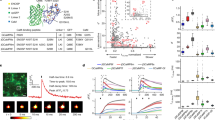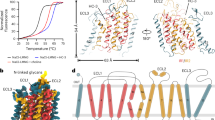Abstract
Binding studies with appropriate labelled ligands have revealed the existence of two types of serotonin (5-HT) receptor, 5-HT1 and 5-HT2, in the central nervous system of mammals1. The 5-HT1 type is characterized by a higher affinity for agonists than for antagonists, whereas the 5-HT2 type binds preferentially to antagonists. However, neither of these receptor types apparently corresponds to the presynaptic autoreceptor controlling 5-HT release2. In an attempt to identify the presynaptic autoreceptor directly, we synthesized the tritiated derivative of 8-hydroxy-2-(di-n-propylamino) tetralin (PAT), a new tetralin derivative with potent 5-HT agonist properties3 and carried out binding studies with rat brain membranes. As we report here, in the hippocampus, the properties of 3H-PAT binding sites correspond closely to those of 5-HT1 sites. In contrast, in the striatum, 3H-PAT binding sites exhibit a subcellular distribution and pharmacological characteristics usually associated with presynaptic autoreceptors. Furthermore, a marked loss of 3H-PAT binding sites occurs in the striatum (but not in the hippocampus) after the selective degeneration of serotoninergic fibres in 5,7-hydroxytryptamine (5,7-HT)-treated rats. Conversely, the sprouting of additional 5-HT terminals in the brain stem of adult rats treated at birth with 5,7-HT is associated with an increased density of 3H-PAT binding sites in this region. 3H-PAT thus seems to be a useful ligand for studying the biochemical and pharmacological characteristics of presynaptic autoreceptors in selected regions of rat brain.
This is a preview of subscription content, access via your institution
Access options
Subscribe to this journal
Receive 51 print issues and online access
$199.00 per year
only $3.90 per issue
Buy this article
- Purchase on Springer Link
- Instant access to full article PDF
Prices may be subject to local taxes which are calculated during checkout
Similar content being viewed by others
References
Peroutka, S. J. & Snyder, S. H. Molec. Pharmac. 16, 687–699 (1979).
Göthert, M. in Basic and Clinical Aspects of Molecular Neurobiology (eds Giuffrida-Stella, A. M., Gombos, G., Benzi, G. & Bachelard, H. S.) 197–206 (Fond. Int. Menarini, Milan, 1982).
Arvidsson, L. E. et al. J. med. Chem. 24, 921–923 (1981).
Nelson, D. L., Herbet, A., Bourgoin, S., Glowinski, J. & Hamon, M. Molec. Pharmac. 14, 983–995 (1978).
Laduron, P. Int. Rev. Neurobiol. 20, 251–281 (1977).
Sette, M., Raisman, R., Briley, M. & Langer, S. Z. J. Neurochem. 37, 40–42 (1981).
Gross, C., Göthert, M., Ender, H.-P. & Schümann, H.-J. Naunyn-Schmiedebergs Archs Pharmak. 317, 310–314 (1981).
Hamon, M., Nelson, D. L., Mallat, M. & Bourgoin, S. Neurochem. Int. 3, 69–79 (1981).
Ennis, C., Kemp, J. D. & Cox, B. J. Neurochem. 36, 1515–1520 (1981).
Schwarcz, R., Zaczek, R. & Coyle, J. T. Eur. J. Pharmac. 50, 209–220 (1978).
Coyle, J. T. & Schwarcz, R. Nature 263, 244–246 (1976).
Zaczek, R., Schwarcz, R. & Coyle, J. T. Brain Res. 152, 626–632 (1978).
Bourgoin, S. et al. J. Pharmacol. exp. Ther. 202, 519–531 (1977).
Cerrito, F. & Raiteri, M. Eur. J. Pharmac. 57, 427–430 (1979).
Schlicker, E. & Göthert, M. Naunyn-Schmiedebergs Archs Pharmak. 317, 204–208 (1981).
Cox, B. & Ennis, C. J. Pharm. Pharmac. 34, 438–441 (1982).
Ennis, C. & Cox, B. Neuropharmacol 21, 41–44 (1982).
Mounsey, I., Brady, K. A., Carroll, J., Fisher, R. & Middlemiss, D. N. Biochem. Pharmac. 31, 49–53 (1982).
Martin, L. L. & Sanders-Bush, E. Neuropharmacology 21, 445–450 (1982).
Martin, L. L. & Sanders-Bush, E. Naunyn-Schmiedebergs Archs Pharmak. 321, 165–170 (1982).
Hamon, M., Gozlan, H. & Goetz, C. in CNS receptors—From Molecular Pharmacology to Behaviour (eds Mandel, P. & De Feudis, F. V.) (Raven, New York, in the press).
Pedigo, N. W., Yamamura, H. I. & Nelson, D. L. J. Neurochem. 36, 220–226 (1981).
Hamon, M., Bourgoin, S., El Mestikawy, S. & Goetz, C. Handbook of Neurochemistry Vol. 6 (ed. Lajtha, A.) (Plenum, New York, in the press).
Leysen, J. E. J. Physiol., Paris 77, 351–362 (1981).
Author information
Authors and Affiliations
Rights and permissions
About this article
Cite this article
Gozlan, H., El Mestikawy, S., Pichat, L. et al. Identification of presynaptic serotonin autoreceptors using a new ligand: 3H-PAT. Nature 305, 140–142 (1983). https://doi.org/10.1038/305140a0
Received:
Accepted:
Issue Date:
DOI: https://doi.org/10.1038/305140a0
This article is cited by
-
Serotonin discovery and stepwise disclosure of 5-HT receptor complexity over four decades. Part II. Some contributions of Manfred Göthert
Pharmacological Reports (2020)
-
Effects of hypothyroidism on serotonin 1A receptors in the rat brain
Psychopharmacology (2018)
-
A short history of the 5-HT2C receptor: from the choroid plexus to depression, obesity and addiction treatment
Psychopharmacology (2017)
-
Repeated exposure to MDMA triggers long-term plasticity of noradrenergic and serotonergic neurons
Molecular Psychiatry (2014)
-
Synthesis and pharmacological evaluation of [(4-arylpiperazin-1-yl)-alkyl]-carbamic acid ethyl ester derivatives as potential anxiolytic agents
Archives of Pharmacal Research (2012)
Comments
By submitting a comment you agree to abide by our Terms and Community Guidelines. If you find something abusive or that does not comply with our terms or guidelines please flag it as inappropriate.



